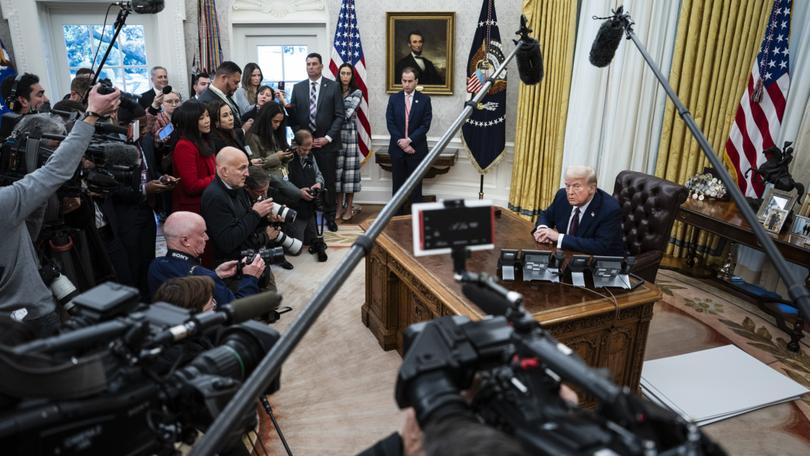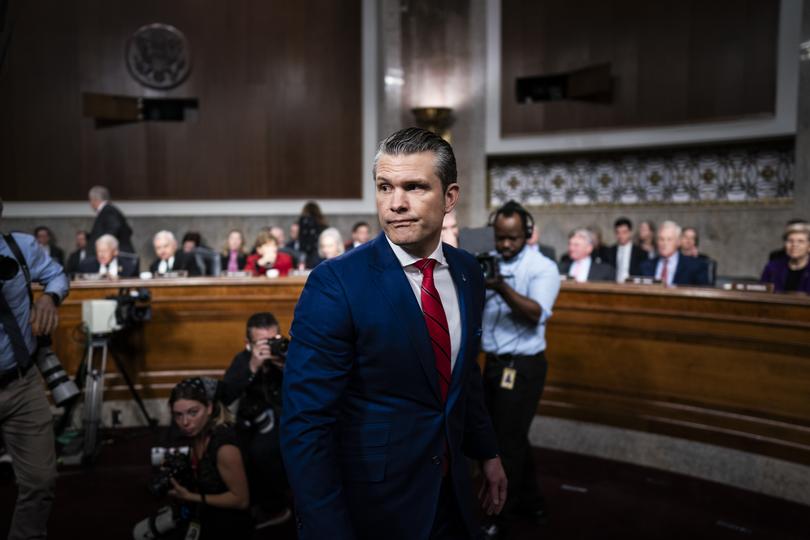Donald Trump’s first-week strategy: ‘Flood the zone.’ Repeat.

President Donald Trump spent his first week back in office flooding the zone.
He pardoned hundreds of supporters who assaulted police on Jan. 6, 2021, revoked security clearances for critics and floated dramatic proposals such as eliminating the Federal Emergency Management Agency.
It was all part of a plan to begin with a bang, follow a detailed policy blueprint and be better organised than eight years ago.
Sign up to The Nightly's newsletters.
Get the first look at the digital newspaper, curated daily stories and breaking headlines delivered to your inbox.
By continuing you agree to our Terms and Privacy Policy.Trump’s ambitions for his first hours in office fell short in some ways, including hiring bottlenecks for key administration jobs, court challenges to executive orders that had eluded legal vetting and directives that lacked immediate effect.
Some agencies are at less than one-third strength in their “beachhead” teams, according to three people familiar with the situation who spoke on the condition of anonymity because they weren’t authorised to speak publicly.
But the president was pleased with his first week, especially after Friday night’s confirmation of one of his most controversial Cabinet picks, Pete Hegseth for defence secretary, a top adviser said. His team welcomed headlines about the military deploying to the southern border and live television coverage of a bipartisan round table where he sparred with Los Angeles Mayor Karen Bass (D) over wildfire recovery.
“Monday you hit, you flood the zone. Second week you’ll flood the zone,” said Stephen K. Bannon, Trump’s first White House chief strategist who now hosts an influential online talk show. “It’s working. It’s just stunning to me what they’re doing, and it’s not getting covered because it’s too much. They’re overwhelming the system.”
During the campaign, Trump made more than 40 distinct promises for Day 1 actions, and one of his top priorities ahead of his inauguration was to show his supporters that he meant it. Trump on Monday said he rejected advice to spread executive actions out over the first week, insisting on signing 26 on Inauguration Day.
White House deputy chief of staff Stephen Miller led policy preparations during the transition and personally drafted or coordinated most of the executive orders Trump signed Monday evening, according to White House officials. Miller did not respond to requests for comment.
Many of the actions overlapped detailed preparations by right-wing think tanks, including the policy blueprint Project 2025. Out of 52 presidential directives (excluding pardons and appointments) that Trump signed by Friday, 28 contained language resembling text published as part of Project 2025, according to a Washington Post analysis. They include withdrawing from the World Health Organisation and Paris Climate Accord. Trump rescinded a Biden administration executive order creating a gender-focused advisory council and a 1965 executive order on contracting discrimination that were specifically identified in Project 2025.
Similarly, the new administration started firing senior civil servants citing career officials using a legal theory gaining popularity among right-wing lawyers and advocated in Project 2025. The firing notices cited the president’s inherent power under the U.S. Constitution rather than any specific legal authority.
“It’s called Project 2025, but it’s bigger than that,” Bannon said, crediting Miller for the ambitious policy agenda along with budget director nominee Russell Vought’s Center for Renewing America and agriculture secretary nominee Brooke Rollins’s America First Policy Institute. “This was a vast effort to think through the executive actions. We’ve had four years and this is what you see.”
Trump and his advisers repeatedly disavowed Project 2025 during the campaign as it became a frequent target for Democratic attacks. But several top incoming officials, including Miller, Vought and “border czar” Tom Homan, contributed to the Project 2025 coalition. The first White House official said the think tanks were taking signals from the Trump campaign’s stated agenda.
“Good ideas are good ideas, it doesn’t matter where they originated,” a second White House official said.
Democratic senators emphasised Project 2025 in criticising Vought’s nomination, with 15 mentions and two poster boards during a half-hour news conference on Thursday. Vought did not respond to requests for comment.
The extensive policy prep did not head off legal challenges, in part because they did not go through the conventional policy making process, which typically includes input from across the executive branch, including legal counsel.
A federal judge on Thursday issued a two-week restraining order blocking Trump from moving forward with an effort to restrict birthright citizenship. “This is a blatantly unconstitutional order,” Judge John C. Coughenour wrote. “Where were the lawyers when this decision was being made?”
The ruling echoed the court orders during Trump’s first term that blocked his ban on travel from Muslim-majority countries. The travel ban was eventually revised and upheld by the Supreme Court.
The first week of Trump’s second term did not see the large-scale demonstrations of resistance like eight years ago, from the Women’s March the day after his first inauguration to the vigils at courthouses and airports during the chaotic implementation of the travel ban.

School systems around the country have been notifying nervous parents about contingency plans in the event of immigration arrests. Government agencies stopped public communications, environmental lawsuits and foreign aid spending. The Pentagon began sending infantry and combat vehicles to the border.
“People feel frozen,” Rep. Val Hoyle (D-Oregon) said. “All the guardrails are gone.”
The White House doesn’t necessarily see court challenges as a setback. On birthright citizenship and some other new policies, officials were expecting to provoke legal challenges, hoping to test even more sweeping arguments with a federal bench that Trump has dramatically shifted to the right.
Still, many of Trump’s early directives lacked immediate effect, instead calling up reviews and reports that could lead to changes later on. For instance, he directed agencies to propose ways to address inflation and asked for a plan to release secret records on past assassinations.
As Trump toured disaster-stricken parts of North Carolina and California on Friday, he told aides that he wanted to eliminate FEMA. Advisers researched the question and came back with a proposal to form a working group to study the agency and make recommendations in three to six months with the benefit of more information, White House officials said.
Clearly, they had done some prep work this time in a way that didn’t happen in 2016 and early 2017.
A small group of White House advisers including Miller are closely directing policy and hiring across the administration, similar to how Trump’s top aides managed his 2024 political campaign. The White House is taking a more targeted approach to place smaller teams of people in positions where they could be more effective, according to an official who spoke on the condition of anonymity.
“In the past, there were a lot of people that went initially and were temporary ‘beachhead’ with no intention of remaining permanent,” another White House official said, also speaking on the condition of anonymity to describe internal strategy. “We took a different approach installing people that would remain in the agency. So those who have gotten hired are staying.”
But the close hold has led to bottlenecks, especially in hiring. The holdup in deploying loyal staff to take over the machinery of government refreshed a frustration from Trump’s first term that many alumni were determined not to repeat.
The White House personnel office was slow to vet appointees and process background checks, leading the president to fast-track provisional security clearances on his first night. Some officials started to grumble that the White House personnel chief, former Fox News booker and Trump book publisher Sergio Gor, could have better used the time he spent travelling this month to Greenland, the Danish territory in the North Atlantic that Trump has said he wants the United States to take over. The first White House official said Gor’s trip lasted less than 24 hours.
Gor told Fox News that the administration set a record for 1300 people hired on the first day and is continuing to vet for the rest of the 4000 political positions throughout the executive branch. The White House official said Gor gave the interview at the request of the communications team.
Many of the initial executive actions dealt with government operations, such as the language used on federal websites and federal materials, or changing federal hiring and contracting practices. Others restored policies from the end of the first Trump administration that Biden had changed in the intervening four years.
In contrast to last week’s deluge of executive actions, eight years ago Trump signed only one executive order on Inauguration Day and none on his second day. But like the first time, Trump’s initial executive actions have immediately run into legal challenges.
Presidents often treat their first 100 days as their best chance for landmark policy achievements on the immediate heels of electoral mandates. The time pressure is historically more acute for second-term presidents, whose political clout typically peaks as they become lame ducks after Year 2.
But it is not clear how those patterns will apply to Trump, who returned to power after a four-year hiatus with unified control of Congress and a party firmly behind him.
“Clearly, they had done some prep work this time in a way that didn’t happen in 2016 and early 2017,” said Andrew Rudalevige, a professor at Bowdoin College who has studied executive actions. “You had a whole group of pretty well funded entities able to focus on what they wanted to do if they could wrest control and could implement Trump’s policies immediately.”
- - -
Jacqueline Alemany, Marianne LeVine, Dan Diamond, Matt Viser and Warren Strobel contributed to this report.
© 2025 , The Washington Post
